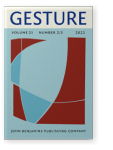Vol. 21:2/3 (2022) ► pp.201–238
Searching for the roots of signs in children’s early gestures
A consolidated tendency considers ‘gestures’ and ‘signs’ as distinct categories separated by a ‘cataclysmic break’. According to a different approach, gestures and signs have their common origin in actions, and are considered as part of language. The aim of this study was to compare the productions of preschool speaking hearing children and signing deaf children in response to the same visual stimuli. The execution parameters and representational strategies observed in gestures and signs were analyzed using the same coding. The results showed that hearing children exposed to Italian and deaf children exposed to Italian Sign Language are consistent in their productions of gestures and signs, respectively. Furthermore, the hearing children’s gestures and the deaf children’s signs for some items were produced with the same parameters and according to similar representational strategies. This indicates that these two forms of communication are not separate behaviors, but should rather be considered as a continuum.
Article outline
- Introduction
- Gestures and signs: A cataclysmic break?
- Gesture as a form of action
- Gestures and signs: The same representational strategies?
- Aim of the study
- Methods
- Participants
- Materials and procedures
- Coding and analysis
- Reliability
- Results
- Execution parameters
- Representational strategies
- Discussion
- Conclusion
- Acknowledgements
- Notes
-
References
